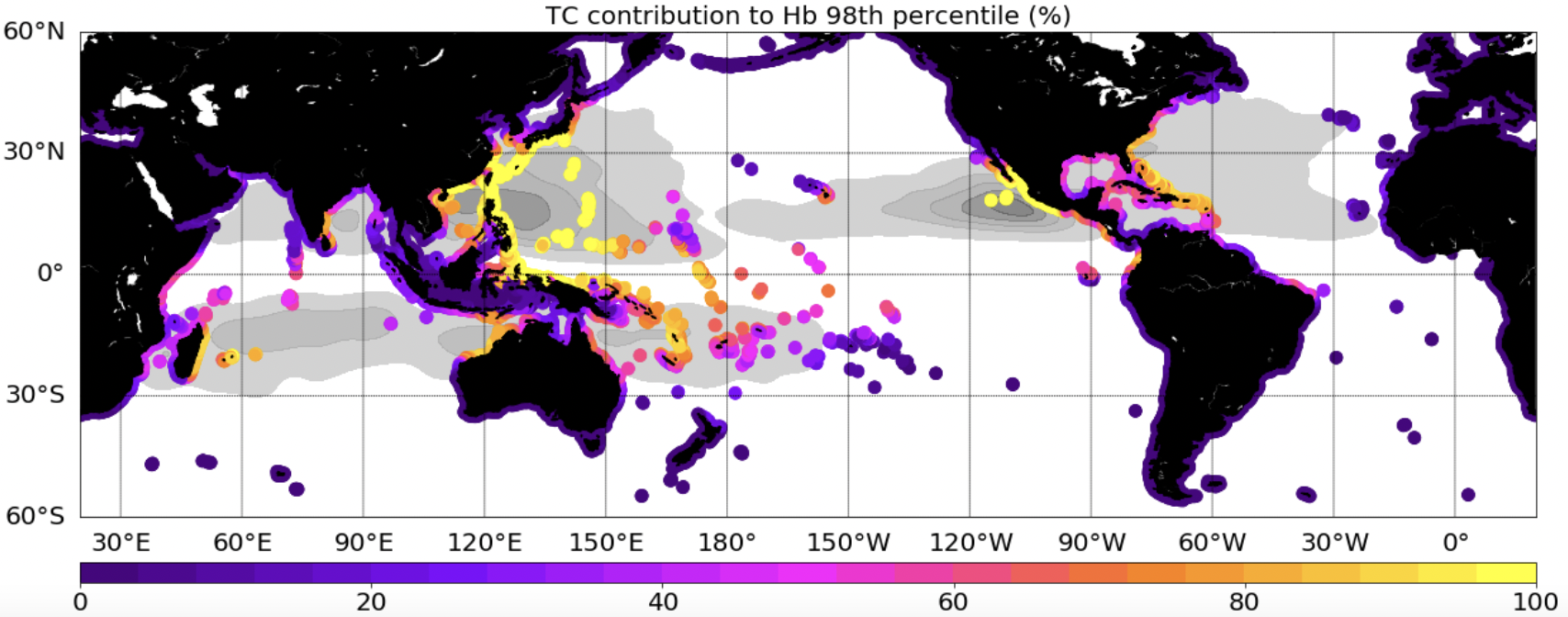Oceanographic geographical features
Type of resources
Available actions
Topics
Keywords
Contact for the resource
Provided by
Years
Formats
Representation types
Update frequencies
status
Service types
Scale
Resolution
-

SpiArcBase is a software developed for the treatment of Sediment Profile images (SPIs). Sediment Profile Images (SPIs) are widely used for benthic ecological quality assessment under various environmental stressors. The processing of the information contained in SPIs is slow and its interpretation is largely operator dependent. SpiArcBase enhances the objectivity of the information extracted from SPIs, especially for the assessment of the apparent Redox Potential Discontinuity (aRPD). This software allows the user to create and manage a database containing original SPIs and corresponding derived pieces of information. Once you have downloaded it, you can ask for help and stablish a helpdesk.
-

Daily air-sea heat fluxes dataset on the last 27 years (1992-2018). Global coverage with 0.25° resolution. Data is mainly coming from aggregated calibrated scatterometer datasets and numerical models. Main geophysical parameters are: sensible heat flux, latent heat flux, wind speed, SST, air temperature. Latest version : 4.1 released in June 2019.
-
Sediment Profile Images (SPIs) are commonly used to map physical, biological and chemical/nutrient gradients in benthic habitats. SpiArcBase is a software that has been developed for the analysis of Sediment Profile Images (SPIs). It has been conceived to improve the objectivity of extracted information (especially the apparent Redox Potential Discontinuity (aRPD). The software presents a graphical user interface designed to enhance the interpretation of features observed on SPIs in an objective manner and to facilitate image management and structures visualization via a data base.The software also allows for the storage of generated data and the automatic computation of a benthic habitat quality index. The facilities provided within JERICONext include access to the software through free downloading and assistance in its utilization.
-

This dataset provides extreme waves (Hs: significant wave height, Hb:breaking wave height, a proxy of the wave energy flux) simulated with the WWIII model, and extracted along global coastlines. Two simulations, including or not Tropical Cyclones (TCs) in the forcing wind field, are provided.
-

EMODnet Physics collection of in situ sea level data as recorded by platforms. The product offers near real time and delayed mode data. It integrates data from major marine and oceanographic initiatives and data repositories
-
A global Group for High Resolution Sea Surface Temperature (GHRSST) Level 3 Collated (L3C) dataset derived from the Advanced Very High Resolution Radiometer (AVHRR) on the European Meteorological Operational-A (MetOp-A) platform (launched 19 Oct 2006). The European Organization for the Exploitation of Meteorological Satellites (EUMETSAT), Ocean and Sea Ice Satellite Application Facility (OSI SAF) is producing SST products in near real time from Metop/AVHRR. Global AVHRR level 1b data are acquired at Meteo-France/Centre de Meteorologie Spatiale (CMS) through the EUMETSAT/EUMETCAST system. SST is retrieved from the AVHRR infrared channels (3.7, 10.8 and 12.0 micrometer) using a multispectral algorithm. Atmospheric profiles of water vapor and temperature from a numerical weather prediction model, together with a radiatiave transfer model, are used to correct the multispectral algorithm for regional and seasonal biases due to changing atmospheric conditions. This global L3C product is derived from full resolution AVHRR l1b data that are re-mapped onto a 0.05 degree grid twice daily. The product format is compliant with the GHRSST Data Specification (GDS) version 2.
-

ERA‐40 is a re‐analysis of meteorological observations from September 1957 to August 2002 produced by the European Centre for Medium‐Range Weather Forecasts (ECMWF)
-
A Group for HIgh Resolution Sea Surface Temperature (GHRSST) dataset for the North Atlantic Region (NAR) from the Advanced Very High Resolution Radiometer (AVHRR) on the NOAA-19 platform (launched 6 Feb 2009). This particular dataset is produced by the European Organization for the Exploitation of Meteorological Satellites (EUMETSAT), Ocean and Sea Ice Satellite Application Facility (OSI SAF) in France. The AVHRR is a space-borne scanning sensor on the National Oceanic and Atmospheric Administration (NOAA) family of Polar Orbiting Environmental Satellites (POES) having a operational legacy that traces back to the Television Infrared Observation Satellite-N (TIROS-N) launched in 1978. AVHRR instruments measure the radiance of the Earth in 5 (or 6) relatively wide spectral bands. The first two are centered around the red (0.6 micrometer) and near-infrared (0.9 micrometer) regions, the third one is located around 3.5 micrometer, and the last two sample the emitted thermal radiation, around 11 and 12 micrometers, respectively. The legacy 5 band instrument is known as AVHRR/2 while the more recent version, the AVHRR/3 (first carried on the NOAA-15 platform), acquires data in a 6th channel located at 1.6 micrometer. Typically the 11 and 12 micron channels are used to derive sea surface temperature (SST) sometimes in combination with the 3.5 micron channel. The highest ground resolution that can be obtained from the current AVHRR instruments is 1.1 km at nadir. The MetOp-A platform is sun synchronous generally viewing the same earth location twice a day (latitude dependent) due to the relatively large AVHRR swath of approximately 2400 km. The NAR products are SST fields derived from 1km AVHRR data that are re-mapped onto a 0.02 degree equal angle grid. In the processing chain, global AVHRR level 1b data are acquired at Centre de Meteorologie Spatiale (CMS) through the EUMETSAT/EUMETCAST system. A cloud mask is applied and SST is retrieved from the AVHRR infrared (IR) channels by using a multispectral technique. The NOAA-19 SST L3P data are compliant with the Group for High Resolution SST (GHRSST) Data Specification (GDS) version 1.7.
-
A global Group for High Resolution Sea Surface Temperature (GHRSST) Level 2P dataset based on retrievals from the Visible Infrared Imaging Radiometer Suite (VIIRS). This sensor resides on the Suomi National Polar-orbiting Operational Environmental Satellite System (NPOESS) Preparatory Project (NPP) satellite launched on 28 October 2011. The VIIRS instrument is a a 22-band, multi-spectral scanning radiometer with a 3040-km swath width that builds on the heritage of the MODIS , AVHRR and SeaWIFS sensors for sea surface temperature (SST) and ocean color. For the infrared bands for SST the effective pixel size is 740 meters at nadir and the pixel size variation across the swath is constrained to no more than 1600 meters at the edge of the swath. However, the processing of this dataset aggregates two pixels into one so the resolution is 1500 meters at nadir. This dataset adheres to the GHRSST Data Processing Specification (GDS) version 2 format specifications.
-
Archive de toutes les données de température de surface (SST) satellite produites dans le cadre du projet international GHRSST. Ifremer est un GDAC pour ces données, miroir du GDAC NASA/JPL. Ces données sont utilisées pour la génération de produits multi-capteurs (CMEMS, Medspiration) mais également dans le cadre d'un grand nombre d'études ou projets nécessitant l'utilisation de mesures de SST. L'archive regroupe plusieurs jeux de données provenant de différents satellite ainsi que des données in situ de référence pour leur validation. Elle est mise à jour en temps quasi-réel depuis 10 ans, avec service de diffusion opérationnelle associé (FTP et HTTP). Une fiche sextant (issue du catalogue CERSAT) sera fournie pour chaque dataset dans cette archive.
 Catalogue PIGMA
Catalogue PIGMA